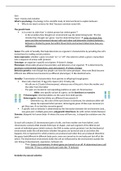Summary
Summary Introduction Psychology 14 chapters
- Course
- Institution
This summary will provide you with the most necessary information that you will need to know for the exam. It it organized in a structured way and therefore will guide you to the right result! (chapter 13 and 14 not yet)
[Show more]



